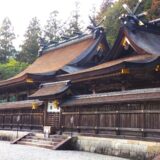【Kumano Nachi Taisya summary】
Kumano Nachi Taisha is one of the three Kumano shrines, along with Kumano Hongu Taisha in Tanabe City and Kumano Hayatama Taisha in Shingu City, and is the head shrine of the approximately 4,000 Kumano shrines in Japan. According to shrine legend, the shrine was founded in the 5th year of Emperor Nintoku. (Seigando-ji Temple is also included in the Sanzan.) This area has a long history as a sacred site of Kumano worship, and was a major training center of the Shinto and Buddhist traditions centering on the Nachi Waterfalls.
![Kumano Nachi Taisya [Wakayama] kumanonachitaisha1 160x160 - Kumano Nachi Taisya [Wakayama]](https://japan-shrine.info/wp-content/uploads/kumanonachitaisha1-160x160.jpg) Seigantoji Temple Three-storied Pagoda and Nachi Waterfall [Wakayama]
Seigantoji Temple Three-storied Pagoda and Nachi Waterfall [Wakayama]
The shrine was called “Musubinomiya” (meaning “the Shrine of Union”) because of the divine virtues of the deity Kumano-Osumi no Mikami, and was revered as a shrine that not only brought people together, but also connected them with each other and with their wishes. Nachi-no-mitaki is also revered by many who respect nature and pray for the prolongation of life and health, as well as by those who pray for the protection of traffic and maritime safety as the god of guidance, based on the legend of Yatagarasu (three-legged crow), and the sacred butagi tree, which symbolizes safety and health. The shrine is a place of deep divine blessings and virtues, as well as the nature of Kumano.
![Kumano Nachi Taisya [Wakayama] DSC 0507 1024x768 - Kumano Nachi Taisya [Wakayama]](https://japan-shrine.info/wp-content/uploads/DSC_0507-1024x768.jpg)
On July 7, 2004, it was registered as a World Heritage site as Kumano Nachi-taisha Shrine in the “Sacred Sites and Pilgrimage Routes in the Kii Mountain Range. Visitors can walk along the Kumano Kodo to reach the main shrine.
![Kumano Nachi Taisya [Wakayama] DSC 0460 1 1024x768 - Kumano Nachi Taisya [Wakayama]](https://japan-shrine.info/wp-content/uploads/DSC_0460-1-1024x768.jpg)
There are 463 more stone steps to climb from the Kumano Kodo, and there are souvenir shops along the way, so it is a good idea to take a break while climbing.

After climbing the long stone steps of the approach, Seigando-ji Temple is on the right, and the vermilion Otorii (Grand Gate) and the precincts of the Taisha Shrine continue on the left. The main shrine is located behind the hall of worship, flanked by the Suzumon Gate and Zuigaki.
![Kumano Nachi Taisya [Wakayama] DSC 0470 1024x768 - Kumano Nachi Taisya [Wakayama]](https://japan-shrine.info/wp-content/uploads/DSC_0470-1024x768.jpg)
When you climb the stairs, pass through the torii gate, and look back, you will be rewarded with a wonderful view. As one would expect from a place of ascetic training, it may be tough for those with weak legs and backs, but there is a sense of accomplishment!
【Kumano Nachi Taisya precincts】
![Kumano Nachi Taisya [Wakayama] DSC 0466 1024x768 - Kumano Nachi Taisya [Wakayama]](https://japan-shrine.info/wp-content/uploads/DSC_0466-1024x768.jpg)
It is a very mysterious shrine with beautiful vermilion pavilions. It is said that the shrine was originally enshrined near Nachi Falls, but was moved to this location 1,700 years ago. Eight of the buildings have been designated as national important cultural properties.
![Kumano Nachi Taisya [Wakayama] DSC 0472 1024x768 - Kumano Nachi Taisya [Wakayama]](https://japan-shrine.info/wp-content/uploads/DSC_0472-1024x768.jpg)
The large camphor tree next to the shrine building is called “Nachi no camphor” and is 850 years old, 25 meters high, and has a trunk circumference of 8.3 meters. It is designated as a natural monument by Wakayama Prefecture.
![Kumano Nachi Taisya [Wakayama] DSC 0474 1024x768 - Kumano Nachi Taisya [Wakayama]](https://japan-shrine.info/wp-content/uploads/DSC_0474-1024x768.jpg)
There is a cave in the root of the temple that is large enough for a person to enter, and one can dedicate the temple by passing through the womb holding a gomafuda with one’s name and wishes drawn on it. It is revered by many people as a place to pray for good health and longevity. The experience of being able to pass through the trees is precious.
![Kumano Nachi Taisya [Wakayama] DSC 0467 1024x768 - Kumano Nachi Taisya [Wakayama]](https://japan-shrine.info/wp-content/uploads/DSC_0467-1024x768.jpg)
Starting from Daimonzaka on the Kumano Ancient Road to Nachi Falls and the main shrine, there is much to see and do. If you are not confident with your legs and back, you can park in the parking lot right next to the temple for 800 yen, so this is a shrine you should visit when you come to Wakayama!
【Kumano Nachi Taisya Access】
Manager’s Comments
It is a place for training. It is not an easy tourist destination, but it is a place that every Japanese person should visit at least once in his or her life. It is interesting to look closely at the boundary between the two temples in a place that still retains strong vestiges of Shintoism and Buddhism, with Seigando-ji Temple next door.
1, Nachiyama, Nachikatsuura-cho, Higashimuro-gun, Wakayama 649-5301, Japan
Parking is available at the souvenir shop parking lot as well as for a fee. (Free of charge only for those who shop at the souvenir shop)
 Tour of Japanese shrines and temples
Tour of Japanese shrines and temples 

![Kumano Nachi Taisya [Wakayama] 3d12e42e2eb562e7055dac42aa018e35 - Kumano Nachi Taisya [Wakayama]](https://japan-shrine.info/wp-content/uploads/sng/3d12e42e2eb562e7055dac42aa018e35.jpg)
![Kumano Nachi Taisya [Wakayama] DSC 0544 150x150 - Kumano Nachi Taisya [Wakayama]](https://japan-shrine.info/wp-content/uploads/DSC_0544-150x150.jpg)
![Kumano Nachi Taisya [Wakayama] kumanonachitaisha1 150x150 - Kumano Nachi Taisya [Wakayama]](https://japan-shrine.info/wp-content/uploads/kumanonachitaisha1-150x150.jpg)
![Kumano Nachi Taisya [Wakayama] kumano hongu taisha oosaihara otorii jp1 150x150 - Kumano Nachi Taisya [Wakayama]](https://japan-shrine.info/wp-content/uploads/kumano-hongu-taisha-oosaihara-otorii-jp1-150x150.jpg)
![Kumano Nachi Taisya [Wakayama] DSC 0581 150x150 - Kumano Nachi Taisya [Wakayama]](https://japan-shrine.info/wp-content/uploads/DSC_0581-150x150.jpg)

